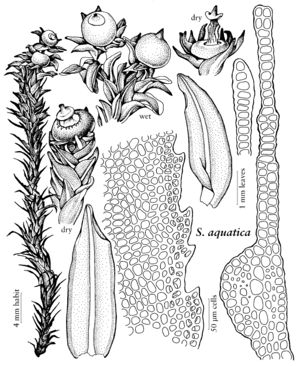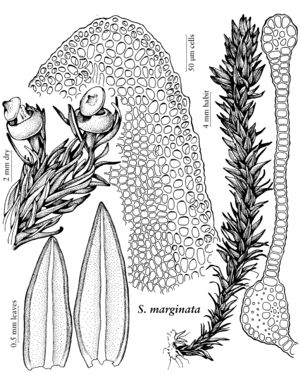Scouleriaceae
Plants medium to large, usually dark green or black with distal portions green. Stems elongate, rarely short, freely branching, transverse section with epidermis, 2–3 outer cortical layers of small, thick-walled cells, inner cortex of large, hyaline, thin-walled cells, central strand absent [present]; rhizoids dense, at base of stems, dark red, smooth, or appearing weakly papillose. Leaves of stem and branch similar, crowded, ligulate to oblong-lanceolate, spreading to recurved when wet; margins entire, weakly to strongly dentate or bluntly serrate in distal half, rarely extending toward base, border present or absent; base slightly clasping, weakly decurrent; apex obtuse to rounded [acute]; costa single, stout, percurrent, abaxial and adaxial surface cells differentiated, thick-walled, stereid cells in 2 bands of 1–3 rows, or absent adaxially, guide cells few, in 1 or rarely 2 rows; basal cells short to long-rectangular, submarginal cells often differentiated as a border, long-rectangular, mostly thin-walled, smooth; medial and distal laminal cells isodiametric, quadrate to subquadrate, smooth, thick-walled. Specialized asexual structures absent. Sexual condition dioicous; perigonia lateral on stem and branches, sessile, perigonial leaves broadly ovate, concave, margins entire, apex obtuse-rounded, costa weak; perichaetia terminal to subterminal, ovate and bluntly acute or rounded, interior leaves ligulate to ovate-lanceolate. Seta single, very short and stout, erect. Capsule erect, immersed to emergent, light to dark brown or rusty red, spherical to obovoid, urn becoming compressed basally and columella with attached operculum appearing exserted when dry, columella persistent; exothecial cells transversely elongate, thick-walled; stomates absent; annulus absent; operculum low-conic, mammillate or apiculate, attached to columella; peristome absent or present, single, when present teeth 32, set below capsule mouth, recurved back on capsule mouth when dry, exterior surface with projecting lamellae, interior surface slightly projecting or not. Calyptra cucullate, entire, smooth, and naked. Spores granulate to gemmate-papillose.
Distribution
North America, s South America, n Asia, Antarctica (subantarctic islands).
Discussion
Genera 2, species 3 (1 genus, 2 species in the flora).

